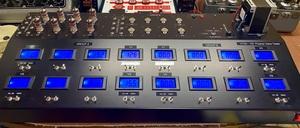This weekend, I worked on a lovely 6 year old, Marshall DSL50 amp head. This was the unit I mentioned in a previous post that was awaiting my attention. It was working however the output valves were mighty hot. I checked the bias on those two beautiful EL34’s and found I could not adjust the bias below 68mA. They were running at 90mA when I first tested the amp. (Update Feb 2018 : we now have six valve testers.)
I recently invested in a digital valve tester and the valves were all fine. Not even worn. I was surprised the EL34’s were still to specification with good gain , especially after getting so hot.
It is easy for anyone with a multi-meter to check the bias on this series of amps. You take off the black metal grill and you see in front of you three prongs. Next to the prongs are the little potentiometers which are adjusted to set the bias current. Connect a multi-meter to the centre pin as that is ground, and the pins to the left and right are the respective EL34’s measuring points. Set the multi-meter to the 200mV range and whatever the mV reading on the multimeter is, that is the bias current ( near enough for this discussion). You are measuiung the voltage across a 1 ohm resistor which is connected in series with the cathode of each of the EL34’s and using good old Ohm’s law 65mV is equivalent to 65mA of bias current. Marshall recommend 45mA for this amp, so it was not surprising that this amp was doubling up as a room heater.
So what was the issue?
In the end, it turned to be the 47uF 63 volt electrolytic capacitors that decoupled the bias circuits had become “leaky” . This meant they were partially short circuiting some of the resistors. Some of the solder joints looked like they were dry so some re-soldering was done too while I replaced the capacitors.
I did test the removed capacitors on my LCR bridge which tests the capacitors. They looked kind of ok on the LCR tester but it only works at low voltage, and not the higher voltages found in amps. So be honest, the test gave me no useful information.
On re-assembly, I then checked and set the bias current. Don’t forget to connect the speaker cabinet(s) unless you want to replace the output transformer too ( mighty expensive !). I set both valves to 45mA per the Marshall bulletin. Make sure you wait till the valves are well warmed up before making the final adjustment. In the first 5 minutes the bias current increases as the EL34’s warm up.
The Result
Having replaced the back plate, I then tried it out. Now the amp produced some beautiful clean tones and now the overdrive sounds were beyond words !! A fabulous amp which was running a lot cooler.
It is worth noting that the owner of this amp used it rarely, and the one thing you should not do with valve /tube amps is leave them sitting and not powered up for months on end. This is why his EL34’s survived as the amp was used so little. Electrolytic capacitors do deteriorate with no use and to be fair to Marshall this is exactly what happened with this amp. My advice is to run any amp for an hour every two weeks. Even if it is just sitting in the corner switched on. This will ensure the electrolytic capacitors stay in good shape = long reliable life !
And Finally……
I replaced the original bias circuit de-coupling capacitors with Panasonic capacitors . Always use the best you can afford. This also ensures a long reliable life.
As always, be aware that there are very high voltages inside these amps so do not go inside if you are not qualified to work in this potential dangerous or fatal environment.
There is another biasing fault that appears on the Marshall DSL50 in fact it is common to many of the JCM2000 series of amps. Check out our bias modification kits . These kits are designed specifically for the JCM200 DSL and TSL amps.
Our company also sells JJ valves , and Russian valves EHX, Genalex, Sovtek and Tung Sol. See our Online shop.
Shopping Basket

